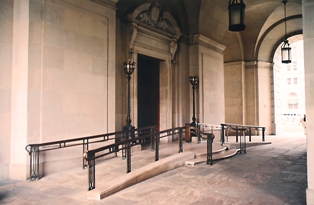Accessible Facility Design

GSA is committed to making Federal buildings and facilities fully accessible to all people. Achieving accessibility is reflected in our commitment to excellence in design, development and construction. We are dedicated to meeting or exceeding Federal, state and local accessibility standards and to ensuring the full integration of individuals with disabilities who use our facilities. Because GSA’s facilities are flexible and adaptable, providing employees and visitors with disabilities the opportunity to take part in all the programs, services and activities our buildings are designed to support is an attainable goal.
What is the Architectural Barriers Act (ABA) and what standards apply?
The Architectural Barriers Act (ABA) enacted by Congress in 1968 requires accessibility in all Federal Government owned and leased buildings and facilities, and also buildings and facilities constructed, altered or leased with certain Federal grants and loans.
GSA is one of four Federal agencies authorized by Congress to issue accessibility standards under the ABA. GSA's current implementing standard is the Architectural Barriers Act Accessibility Standard (ABAAS). ABAAS was made effective May 9, 2006 for new construction and alterations, June 30, 2006 for lease-construction facilities, and February 7, 2007 for all other leased facilities. ABAAS replaces the Uniform Federal Accessibility Standards (UFAS), which was GSA’s previous standard for accessibility. Application of ABAAS is specified in GSA’s Federal Management Regulation (subpart c). Unless specifically exempted by ABAAS, all public use areas, common use areas, and employee areas must be accessible, and accessible routes must connect all accessible spaces.
Who must comply with the ABA Accessibility Standard?
Any person involved in the design, construction, alteration and leasing of federally owned or leased facilities, such as:
Architects/Engineers/Designers
General Contractors
Realty Specialists
Building Managers
Building Owners
Who enforces the ABA?
The ABA is enforced by the United States Architectural and Transportation Barriers Compliance Board (Access Board). The ABA compliance process emphasizes informal resolution. However, if informal resolution cannot be achieved, the Access Board can initiate formal proceedings before an administrative law judge to obtain an order of compliance. Penalties for non-compliance can include the withholding or suspension of Federal funds with respect to the building found not to be in compliance with ABAAS.
Who do I contact for technical assistance with the requirements of the ABA Accessibility Standard?
GSA has a National Accessibility Officer and eleven Regional Accessibility Officers who are responsible for the implementation of GSA’s National Accessibility Program. They can be contacted for technical information and assistance concerning the application of ABAAS to our facilities.
View complete listing of Accessibility Officers.
In addition, the U.S. Access Board provides information about the Architectural Barriers Act (ABA) by telephone, fax or e-mail. Design professionals and others can contact the Access Board to ask questions about general or specific ABA requirements including questions about GSA’s ABA Accessibility Standard.
Contact the Access Board at:
Phone (voice): (202) 272-0080 toll free: (800) 872-2253
Phone (TTY): (202) 272-0082 toll free: (800) 993-2822
Fax: (202) 272-0081
E-mail: TA@access-board.gov
What is GSA’s policy for accessible design?
It is GSA’s policy to make all Federal buildings accessible without the use of special facilities for persons with disabilities. The intent of this policy is to use standard building products set at prescribed heights and with prescribed maneuvering clearances to allow easy use by employees and visitors with disabilities.
In addition to ABAAS, are other accessibility standards used by GSA for accessible design?
ABAAS is mandatory for all GSA design and construction projects. The A/E is also responsible for compliance with all applicable state or local accessibility standards. Where such exist, the most stringent accessibility requirements are to be applied regardless of whether they are contained in state or local codes and regulations or ABAAS.
Are construction tolerances permitted in ABAAS?
Where dimensions for clearances are stated in ABAAS, allowance must be made for construction tolerances in the design to ensure that the finished construction is in full compliance with the stated dimensions.
Is ABAAS Retroactive?
Where existing, unaltered elements of a building or facility comply with an earlier ABA standard such as UFAS, they are not required to be retrofitted to comply with ABAAS. However, if these elements are altered, they must comply with ABAAS or a future implementing standard of the ABA that is applicable at the time of the alteration.
What are some of the major elements of a Federal building or facility that must be on accessible routes, where planning for accessibility is critical?
Entrance doors, entrance vestibules, interior doors, corridors, toilet rooms, telephones and TTYs, drinking fountains, visible and audible alarms, signage, wheelchair seating in assembly areas and dining facilities, service counters, and ramps or elevators where changes in level are necessary.
For more information regarding accessibility, visit Frequently Asked Questions.




